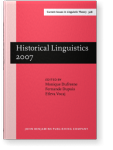Temporal reference and grammaticalization in the Spanish perfect(ive)
Much research has discussed the perfect⇒perfective grammaticalization path, but more diachronic research is needed in order to detail the process. In varieties of Peninsular Spanish, the Present Perfect (PP) is grammaticalizing into a perfective, expanding into contexts of use previously occupied by the Preterite. The data for this study, drawn from 15th, 17th and 19th centuries dramatic texts, as well as 20th century conversation, allow for comparison of the relative frequencies of the two forms and examination of the PP and Preterite in different temporal reference contexts. In the 15th century, the Preterite was the preferred form overall, but the PP occupied Immediately Preceding, Irrelevant and Indeterminate contexts to some degree. By the 20th century, a shift in relative frequency had taken place and the PP was more frequent than the Preterite. It had also extended in all temporal reference contexts, except those of prehodiernal events where the Preterite dominates.
Cited by (1)
Cited by one other publication
This list is based on CrossRef data as of 12 august 2024. Please note that it may not be complete. Sources presented here have been supplied by the respective publishers.
Any errors therein should be reported to them.
